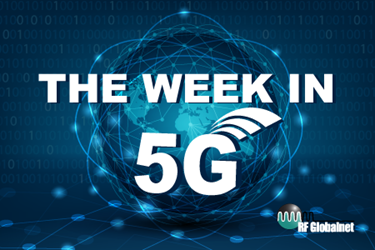The Week in 5G: 8/12/21 — Huawei Revenue Drops; T-Mobile To Retire 3G & LTE

By Abby Proch, former editor

For the first time in more than seven years, Huawei is not one of the top five smartphone brands in China by sales, reports The Associated Press, citing a Canalys research note.
What’s more, Huawei’s revenue dropped 29.4% year over year for the first half of 2021 and its revenue fell from $70.2 billion to $49.6 billion. Though some decline is due to plummeting cell phone sales and the 2020 sell off of its Honor smartphone brand, Huawei also blamed the crippling effect of U.S. sanctions and a semiconductor chip shortage that is now creeping its way from the automotive world into the cell phone industry.
The chip shortage has forced Huawei to release its latest line of smartphones without 5G capability, according to CNBC. Huawei says the omission of 5G technology is due to chip factory closures and heightened consumer demand caused by the COVID-19 pandemic, as well as global stockpiling of chips. Richard Yu, CEO of Huawei’s consumer business group, also claims the chip shortage stems from U.S. sanctions that ban Chinese use of U.S. hardware and software.
In another potential blow to Huawei, U.S. National Security Advisor Jake Sullivan compelled Brazilian officials to forgo a relationship with China and instead team with the U.S. to build its 5G network, reports The Economic Times. Reports suggest the move would help Brazil become a NATO global partner since using unreliable communications suppliers, such as those in China, prompts defense and security concerns, thus hindering cooperation between the U.S. and Brazil on those fronts.
A similar ban on Chinese-made telecoms equipment by the Swedish government also threatened the vitality of Ericsson. Yet, despite losing market share in China in recent years, Ericsson recently won a 3% share in a combined 5G radio contract with telecom operators China Telecom and China Unicom covering thousands of new base stations, says Reuters. Huawei is understood to have gained a larger share of the contract, though the exact percentage has not been released.
Ericsson rival Nokia reported increased Q2 profits last week, more than doubling its Q2 2020 take of $316 million with $640 million this year — a 71 percent increase, according to the AP. Sales climbed 4% at $6.2 billion. The stronger quarter suggests the 5G network provider has regained financial footing even though newly named CEO Pekka Lundmark said the company would endure short-term loss in order to rise as the global leader in 5G services. Lundmark said some of Nokia’s challenges include deteriorating market share in the U.S. and meager shares in China.
In other Nokia news, the Finnish 5G carrier — alongside Taiwan Mobile — claims to have combined spectrum in 700MHz (n28) and 3500MHz (n78) to create the first-ever New Radio carrier aggregation (NRCA), says Yahoo. The trial occurred in a 5G standalone network environment and, if implemented, would improve network capacity and coverage for Taiwan Mobile.
In other spectrum news, Canada collected more $10 billion CAD in a 3.5 GHz auction for 5G spectrum, according to provisional auction results. While the top winners included some of Canada’s largest carriers — Rogers Communication Canada won 325 licenses costing $3.3 billion CAD, Vidéotron ltée won 294 licenses for $829 million CAD, and Bell Mobility won 271 licenses for $2.1 billion CAD — smaller carriers didn’t walk away empty handed.
Authorities set aside 50 MHz of the total 200 MHz to accommodate small and regional competitors to ensure affordability for those agencies as they sidle up to larger operators with deeper pockets. There were 1,504 licenses distributed among 21 careers. The licenses are good for the next 20 years.
On a global scale, Inmarsat claims its new ORCHESTRA communications network will redefine connectivity by providing the fastest speeds, the lowest average latency and highest capacity. It’s a tall order, but Inmarsat says ORCHESTRA will fulfill its mission via a “dynamic mesh network” of terrestrial, satellite and geosynchronous networks.
ORCHESTRA will layer existing 5G, L-band and GX networks with a new low earth orbit (LEO) network, comprised of 150-175 satellites. The initiative will address communications congestion in high-traffic transportation networks like ports, airports, channels, and flight corridors. Deployment begins in 2022.
While Inmarsat is ramping up its networks, T-Mobile announced plans to retire some of its own. T-Mobile is retiring all 3G and LTE networks in 2022. Sprint’s 3G (CDMA) network will cease operations Jan. 1, followed by its LTE network on June 22. T-Mobile merged with Sprint in April 2020. Shutting down the increasingly outdated technologies will free up spectrum and company resources, as well as strengthen the telecom’s entire network, states a company press release.
T-Mobile also claims the upgraded 5G service will make broadband speeds 100 to 300 times faster than existing speeds and enhance location identification to support public safety and emergency services.
Rounding out the week in 5G, Fisk University is changing how future medical professionals gain their hands-on experience, according to Business Wire. Fisk students will soon explore human anatomy in a 5G-powered virtual reality human cadaver lab. Swapping lab coats for HTC VIVE VR headsets, pre-med students will concurrently explore and examine human cadavers virtually, allowing the university to forgo costly cadavers and provide modern, easy-to-maintain educational experiences. Add-ons include software for surgical procedures and cellular-level exploration.
